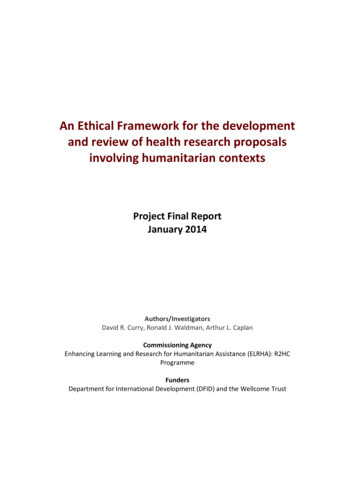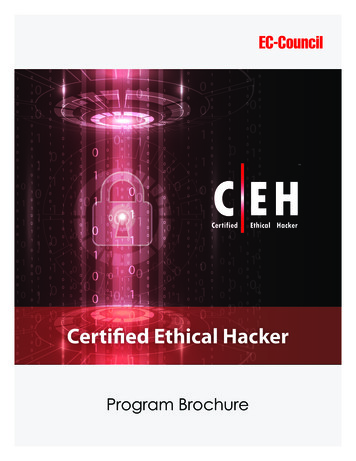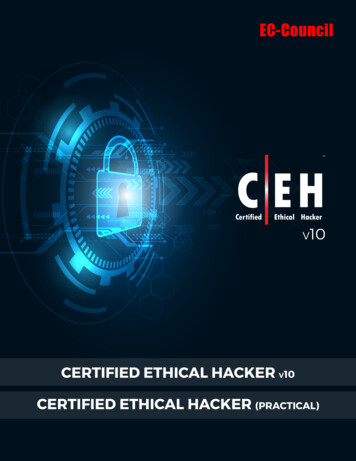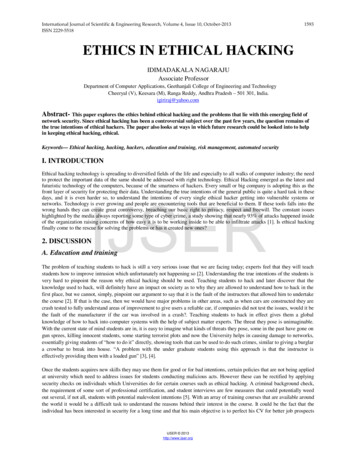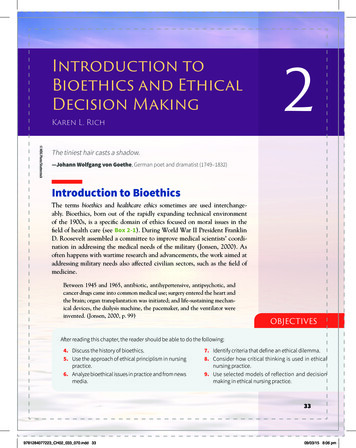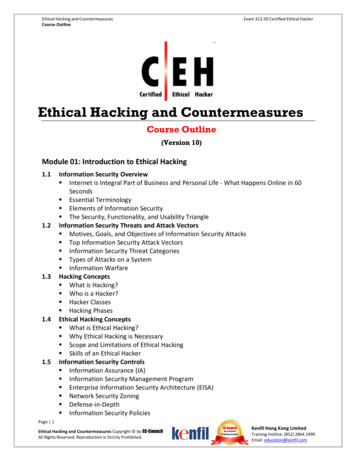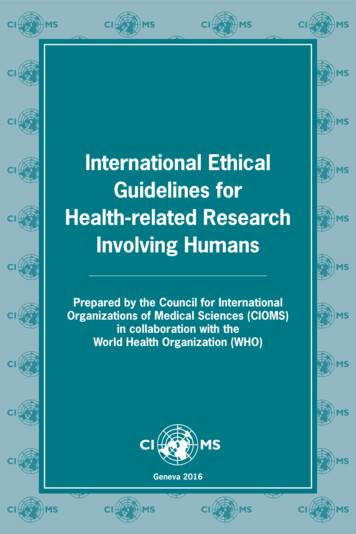
Transcription
International EthicalGuidelines forHealth-related ResearchInvolving HumansPrepared by the Council for InternationalOrganizations of Medical Sciences (CIOMS)in collaboration with theWorld Health Organization (WHO)Geneva 2016
International EthicalGuidelines forHealth-related ResearchInvolving HumansPrepared by the Council for InternationalOrganizations of Medical Sciences (CIOMS)in collaboration with theWorld Health Organization (WHO)Geneva 2014
Copyright 2016 by the Council for International Organizations of Medical Sciences (CIOMS)ISBN 978-929036088-9All rights reserved. CIOMS publications may be obtained directly from:CIOMS, P.O. Box 2100, CH-1211 Geneva 2, Switzerland, tel.: 41 22 791 6497, www.cioms.ch,e-mail: info@cioms.ch.CIOMS publications are also available through the World Health Organization, WHO Press, 20 AvenueAppia, CH-1211 Geneva 27, Switzerland.Citation for this document:International Ethical Guidelines for Health-related Research Involving Humans, Fourth Edition. Geneva.Council for International Organizations of Medical Sciences (CIOMS); 2016.The authors alone are responsible for the views expressed in this publication and those views do notnecessarily represent the decisions, policies or views of their respective institutions or companies.Design and Layout: Paprika (Annecy, France)
ACKNOWLEDGEMENTSThe Council for International Organizations of Medical Sciences (CIOMS) acknowledges the contributionof the Working Group for the revision of the CIOMS Ethical Guidelines. In 2011, the ExecutiveCommittee of CIOMS decided to set up a Working Group to revise the CIOMS Guidelines. The WorkingGroup consisted of 10 members (Anant Bhan, Eugenijus Gefenas, Dirceu Greco, David Haerry, BocarKouyate, Alex John London, Ruth Macklin, Annette Rid, Rodolfo Saracci, Aissatou Touré, one chair(Hans van Delden), four advisers, from WHO (Marie-Charlotte Bouësseau and later Abha Saxena),UNESCO (Dafna Feinholz), COHRED (Carel Ijsselmuiden) and WMA (Urban Wiesing and Hans-JoergEhni) and one scientific secretary (Rieke van der Graaf). All members of the Working Group wereinternationally recognized for their expertise in research. The composition of the Working Groupensured that different cultural perspectives were present, members varied in experience andexpertise, and gender balance was achieved. One of the members represented the perspective ofresearch participants. Their affiliations are indicated in Appendix 3.CIOMS is grateful for the valuable contributions of many commentators on its first draft from individualpersons and institutions (see Appendix 4). Their detailed review and comments have greatly helpedto shape the final document.A number of institutions and organizations made valuable contributions by providing hospitality tohost meetings of the Working Group (Utrecht University, Netherlands; Vilnius University, Lithuania;and UNESCO, Paris, France).Special thanks are due to Carla Saenz and Tania Flores at PAHO, who at no cost translated commentssubmitted by Spanish-speaking persons and organizations into English. Their work has beentremendously helpful in ensuring meaningful global involvement in the revision process.The revision of these Guidelines has been carried out in collaboration with World Health Organization(WHO), the facilitation of which was led by Abha Saxena. As a result of this collaboration, the guidelinedevelopment process is consistent with the standards and policies of WHO. The organization-widereview by WHO especially by the Ethics Review Committee was coordinated by Maria MagdalenaGuraiib and Vânia de la Fuente Nunez. Ronald Johnson, Melba Gomes, Joan Dzenowagis and SherylVanderPoel have provided substantial inputs to the draft document.At CIOMS, Sev Fluss edited the draft document and provided constructive comments, and GunillaSjölin-Forsberg, the Secretary-General (SG) of CIOMS until the end of 2015, attended many meetingsof the Working Group and contributed her experience from the many other Working Groups in whichshe has participated. Lembit Rägo has supported the revision work after becoming the new SG inApril 2016. Finally, Caprice Fraiha and Sue le Roux have helpfully provided administrative supportfor the revision process.INTERNATIONAL ETHICAL GUIDELINES FOR HEALTH-RELATED RESEARCH INVOLVING HUMANSiii
CONTENTSACKNOWLEDGEMENTS IIIPREFACE VIIIEVIDENCE RETRIEVAL AND SYNTHESIS XIPREAMBLE XIIGUIDELINE 1: SCIENTIFIC AND SOCIAL VALUE AND RESPECT FOR RIGHTS 1GUIDELINE 2: RESEARCH CONDUCTED IN LOW‑RESOURCE SETTINGS 3GUIDELINE 3: EQUITABLE DISTRIBUTION OF BENEFITS AND BURDENSIN THE SELECTION OF INDIVIDUALS AND GROUPS OF PARTICIPANTSIN RESEARCH 7GUIDELINE 4: POTENTIAL INDIVIDUAL BENEFITS AND RISKS OF RESEARCH 9GUIDELINE 5: CHOICE OF CONTROL IN CLINICAL TRIALS 15GUIDELINE 6: CARING FOR PARTICIPANTS’ HEALTH NEEDS 21GUIDELINE 7: COMMUNITY ENGAGEMENT 25GUIDELINE 8: COLLABORATIVE PARTNERSHIP AND CAPACITY-BUILDINGFOR RESEARCH AND RESEARCH REVIEW 29GUIDELINE 9: INDIVIDUALS CAPABLE OF GIVING INFORMED CONSENT 33GUIDELINE 10: MODIFICATIONS AND WAIVERS OF INFORMED CONSENT 37INTERNATIONAL ETHICAL GUIDELINES FOR HEALTH-RELATED RESEARCH INVOLVING HUMANSv
GUIDELINE 11: COLLECTION, STORAGE AND USE OF BIOLOGICALMATERIALS AND RELATED DATA 41GUIDELINE 12: COLLECTION, STORAGE AND USE OF DATA IN HEALTHRELATED RESEARCH 47GUIDELINE 13: REIMBURSEMENT AND COMPENSATION FORRESEARCH PARTICIPANTS 53GUIDELINE 14: TREATMENT AND COMPENSATION FOR RESEARCHRELATED HARMS 55GUIDELINE 15: RESEARCH INVOLVING VULNERABLE PERSONSAND GROUPS 57GUIDELINE 16: RESEARCH INVOLVING ADULTS INCAPABLE OF GIVINGINFORMED CONSENT 61GUIDELINE 17: RESEARCH INVOLVING CHILDREN AND ADOLESCENTS 65GUIDELINE 18: WOMEN AS RESEARCH PARTICIPANTS 69GUIDELINE 19: PREGNANT AND BREASTFEEDING WOMEN ASRESEARCH PARTICIPANTS 71GUIDELINE 20: RESEARCH IN DISASTERS AND DISEASE OUTBREAKS 75GUIDELINE 21: CLUSTER RANDOMIZED TRIALS 79GUIDELINE 22: USE OF DATA OBTAINED FROM THE ONLINEENVIRONMENT AND DIGITAL TOOLS IN HEALTH-RELATED RESEARCH 83GUIDELINE 23: REQUIREMENTS FOR ESTABLISHING RESEARCH ETHICSCOMMITTEES AND FOR THEIR REVIEW OF PROTOCOLS 87viINTERNATIONAL ETHICAL GUIDELINES FOR HEALTH-RELATED RESEARCH INVOLVING HUMANS
GUIDELINE 24: PUBLIC ACCOUNTABILITY FOR HEALTH-RELATED RESEARCH 91GUIDELINE 25: CONFLICTS OF INTEREST 95APPENDIX 1 ITEMS TO BE INCLUDED IN A PROTOCOL (OR ASSOCIATEDDOCUMENTS) FOR HEALTH-RELATED RESEARCH INVOLVING HUMANS 99APPENDIX 2 OBTAINING INFORMED CONSENT: ESSENTIALINFORMATION FOR PROSPECTIVE RESEARCH PARTICIPANTS 103APPENDIX 3 CIOMS WORKING GROUP ON THE REVISION OF THE2002 INTERNATIONAL GUIDELINES FOR BIOMEDICAL RESEARCHINVOLVING HUMANS 107APPENDIX 4 COMMENTATORS 113INDEX 119INTERNATIONAL ETHICAL GUIDELINES FOR HEALTH-RELATED RESEARCH INVOLVING HUMANSvii
PREFACEAbout CIOMSThe Council for International Organizations of Medical Sciences (CIOMS) is an internationalnongovernmental organization in official relationship with World Health Organization (WHO). It wasfounded under the auspices of WHO and the United Nations Educational, Scientific and Cultural andOrganization (UNESCO) in 1949. Among its mandates is maintaining collaborative relations with theUnited Nations and its specialized agencies, especially UNESCO and WHO.The first version of the CIOMS Guidelines (1982)CIOMS, in association with WHO, undertook its work on ethics in biomedical research in the late1970s. Accordingly, CIOMS set out, in cooperation with WHO, to prepare guidelines. The aim of theguidelines was (and still is) to provide internationally vetted ethical principles and detailed commentaryon how universal ethical principles should be applied, with particular attention to conducting researchin low-resource settings. The outcome of the CIOMS/WHO collaboration was entitled ProposedInternational Ethical Guidelines for Biomedical Research Involving Human Subjects.The second version of the CIOMS Guidelines (1993)The period that followed saw the outbreak of the HIV/AIDS pandemic and proposals for large-scaletrials of prevention and treatment for the disease. These developments raised new ethical issuesthat had not been considered in the preparation of the Proposed Guidelines. There were otherfactors also – rapid advances in medicine and biotechnology, changing research practices suchas multinational field trials, experimentation involving vulnerable population groups, and also anew perspective in both high- and low-resource settings, that research involving humans could bebeneficial to participants rather than threatening. The World Medical Association’s Declaration ofHelsinki was revised twice in the 1980s – in 1983 and 1989. It was timely to revise and update the1982 Guidelines, and CIOMS, with the collaboration of WHO and its Global Programme on AIDS,undertook the task. The outcome was the issue of two sets of guidelines: International Guidelines forEthical Review of Epidemiological Studies in 1991, and International Ethical Guidelines for BiomedicalResearch Involving Human Subjects in 1993.The third version of the CIOMS Guidelines (2002)After 1993, ethical issues arose for which the 1993 CIOMS Guidelines had no specific provisions.They related mainly to externally sponsored clinical trials carried out in low-resource settings.In particular, the use of comparators other than an established effective intervention used in lowresource settings became a concern. Commentators took opposing sides on this issue. This debatenecessitated the revision and updating of the 1993 Guidelines. CIOMS organized a consultationmeeting with eight commissioned papers. After this meeting, a WG was set up that laboured over aperiod of two years during which there was a public posting of a draft with a request for comments.The revision process was finished in 2002.Epidemiological Guidelines (2009)The process of revising the 1993 version of the biomedical research Guidelines made clear thatdevelopments in the ethical analysis of all types of research using human subjects had potentialimplications for the 1991 Guidelines for epidemiological studies. Furthermore, the growing recognitionof the importance of epidemiological research to improving the health of the public highlighted theviiiINTERNATIONAL ETHICAL GUIDELINES FOR HEALTH-RELATED RESEARCH INVOLVING HUMANS
importance of bringing the 1991 Guidelines into line with current thinking on ethics and humanrights. Therefore, in 2003 CIOMS constituted a core group to consider how the existing ethicalguidance for epidemiological studies should be updated. Intending to ensure that ethical principlesare consistently applied to all types of research, the core group decided to prepare a Supplement tothe 2002 document that would address the special features of epidemiological studies. In February2006, a draft of the supplement was posted on the CIOMS website and opened to comment frominterested parties. The response from groups and individuals involved in biomedical research waslargely positive, but many objected that epidemiologists were not necessarily conversant with the2002 Guidelines and would therefore find it burdensome to have to switch back and forth betweenthe epidemiology supplement and the biomedical research document. Eventually, therefore, the finalversion of the Guidelines (2009) combined both documents.The fourth version of the CIOMS Guidelines (2016)During its annual meeting in 2009 the Executive Committee of CIOMS considered the desirability of arevision of the CIOMS Ethical Guidelines for Biomedical Research. Since 2002 several developmentshad taken place including: a heightened emphasis on the importance of translational research, a feltneed to clarify what counts as fair research in low-resource settings, more emphasis on communityengagement in research, the awareness that exclusion of potentially vulnerable groups in manycases has resulted in a poor evidence base, and the increase of big data research. Moreover theDeclaration of Helsinki of 2008 was revised again at that moment. The Executive Committee thereforedecided to first explore the desirability of such a revision.The revision process of the 2002 versionIn 2011, the CIOMS Executive Committee decided to set up a Working Group to revise theCIOMS Guidelines and fund the work from internal means. This Group met three times each yearfrom September 2012 until September 2015. Virtually all Guidelines underwent major revisions.Some Guidelines were merged (for example, 2002 Guidelines 4 and 6 both dealt with informedconsent), and others were newly created (for example, Guideline 20 on research in disaster anddisease outbreaks). Furthermore, the Working Group decided to merge the CIOMS Guidelines forBiomedical Research with the CIOMS Guidelines for Epidemiological Research. At the same time,in order to ensure the epidemiological dimension, an epidemiologist, who was also a member of theWorking Group, closely read the revisions from an epidemiological perspective.Scope of the 2016 versionThe Working Group decided to broaden the scope of the 2002 Guidelines from “biomedical research”to “health-related research”. The Working Group considered biomedical research too narrow since thatterm would not cover research with health-related data, for example. At the same time, the WorkingGroup acknowledged that this new scope also had limits. For example, new developments suchas the idea of the Learning Healthcare System that tries to integrate forms of research and care,were beyond the scope of the draft of the Working Group. The Working Group also acknowledgedthat there is no clear distinction between the ethics of social science research, behavioural studies,public health surveillance and the ethics of other research activities. The current scope is confinedto the classic activities that fall under health-related research with humans, such as observationalresearch, clinical trials, biobanking and epidemiological studies.Collaboration with WHOThe CIOMS Guidelines have always been written in collaboration with WHO. For the currentGuidelines, the nature and scope of this collaboration were better defined with a joint decisionINTERNATIONAL ETHICAL GUIDELINES FOR HEALTH-RELATED RESEARCH INVOLVING HUMANSix
to follow recommendations of the WHO Guidelines Review Committee (GRC). This includes (i) adescription of the process of revision, prior to revision; (ii) ensuring that the Working Group is globalin representation, and includes regional balance and representation of all stakeholders, with a clearprocess for reporting and managing conflicts of interests; (iv) providing information on the processof evidence retrieval and synthesis for the revision of the Guidelines; and (v) ensuring an independentexternal peer review of the final product. The GRC acknowledged that many of the “review questions”may not require a full “systematic review” and quality assessment but the process of retrievinginformation needed to be documented.The process of development and revision of these Guidelines was discussed with, and approvedby, the WHO GRC. The final draft of these Guidelines was reviewed by the Secretariat of the GRC,which concluded that since these Guidelines are related to values and moral principles, they wereexempted from GRC review. Collaboration with WHO has included a review of the draft Guidelines byall WHO offices (Regional Offices and Headquarters) and the network of WHO Collaborating Centres onBioethics. Members of the WHO Research Ethics Review Committee reviewed the entire document intwo half-day meetings and provided extensive comments on the 2015 draft version of the document.International consultation and peer reviewIn June 2014 the Working Group organized a symposium during the 12th World Congress of theInternational Association of Bioethics (IAB) in Mexico City during which key issues were presentedand opened for discussion. This session served as one element of the international consultationprocess for the proposed revision of the CIOMS Guidelines. In November 2014 the draft revision wasdiscussed at the Forum of Ethical Review Committees in the Asian & Western Pacific Region (FERCAP)in Manila in a plenary session with more than 800 attendees. The revision was also discussed at theAdvancing Research Ethics Training in Southern Africa (ARESA) Seminar on 17—18 September 2015in Cape Town and at CENTRES (Clinical Ethics Network & Research Ethics Support), in Singaporein November 2015.Specific feedback was sought from the member organizations of CIOMS and from members ofNational Ethics Committees participating in the Global Summit of National Ethics Committees (2014).At the end of September 2015 the Working Group opened its draft guidelines for public commentsuntil 1 March 2016. The Working Group received comments from 57 different institutions andorganizations. In many cases these comments were prepared by several persons from one institution.The commentators represented all parts of the world (see Appendix 4). The Working Group receivedover 250 pages of comments, ranging from minor editorial issues to in-depth, detailed comments.In June 2016 the Working Group met a final time.The close cooperation with the World Medical Association during the revision process ensured thatthe final draft was in line with the Declaration of Helsinki.At the beginning of October 2016 the final draft was submitted to the CIOMS Executive Committee,which approved the text at its General Assembly meeting in Geneva in November 2016.The final draft replaces all previous versions of the CIOMS ethical guidelines, both in the domainof biomedical and epidemiological research. At the same time, research projects that have beenethically assessed on the basis of previous versions of the guidelines may be continued on the termsand conditions as set out in those previous versions.Reactions to the Guidelines are welcome and should be addressed to the Secretary-General, Councilfor International Organizations of Medical Sciences, P.O. Box 2100, CH-1211 Geneva 2, Switzerland;or by email to info@cioms.ch.xINTERNATIONAL ETHICAL GUIDELINES FOR HEALTH-RELATED RESEARCH INVOLVING HUMANS
EVIDENCE RETRIEVAL AND SYNTHESISIn the revision process, literature reviews were used as sources for further ethical deliberation.Authoritative declarations, reports and guidance documents have had a prominent role in thesediscussions, such as the Nuremberg Code (1947), the Universal Declaration of Human Rights of theUnited Nations (1948), the International Covenant on Civil and Political Rights of the United Nations(1966), the Belmont Report (1979), the Guideline on Good Clinical Practice (GCP) of the InternationalConference on Harmonisation of Technical Requirements for Registration of Pharmaceuticals for HumanUse (ICH) (1996), the Oviedo Convention of the Council of Europe (1997), the Universal Declarationon Bioethics and Human Rights of UNESCO (2005), the UNAIDS/WHO Ethical Considerations inBiomedical HIV Prevention Trials (2007/2012), Standards and operational guidance for ethicsreview of health-related research with human participants of the WHO (2011), and the Declarationof Helsinki of the World Medical Association (2013). Some of these guidelines have been extensivelyused, in particular the UNAIDS/WHO document (2012) for Guideline 7 on community engagement.Textbooks, existing ethical frameworks for human subjects research and reports on research involvinghuman beings were also valuable sources of information. The Working Group reviewed papers inmajor ethics journals (in alphabetical order) such as the American Journal of Bioethics, Bioethics,BMC Medical Ethics, the Cambridge Quarterly of Healthcare Ethics, Developing World Bioethics,the Hastings Center Report, the Journal of Bioethical Inquiry, the Journal of Empirical Research onHuman Research Ethics, the Journal of Law, Medicine and Ethics, the Journal of Medical Ethics,the Journal of Medicine and Philosophy, Medicine, Health Care and Philosophy, as well as articlesin leading medical or scientific journals, such as BMJ, The Lancet, the New England Journal ofMedicine and Science.Literature reviews were used in three ways. First, we searched main ethical guidelines on researchwith humans and textbooks on research ethics to identify new topics or viewpoints in existing debates.For instance, many guidelines have included statements on biobanking which was one of the reasonsto merge the CIOMS guidelines for epidemiological research with those for biomedical research.We performed searches in Embase and Medline on review papers and papers with strong positionson certain topics. For example, component analysis and the net risk test are two recent approachesto making risk-benefit assessments. There is no agreement among bioethicists on which of theseapproaches is preferable. The Working Group read relevant papers on these approaches and developeda middle ground. A similar process was adopted for vulnerability. A consensus emerged in recentpublications that vulnerability can no longer be applied to entire groups. As a result, the WorkingGroup eliminated the group approach. Instead, the Guidelines focus on characteristics that lead toconsidering certain groups as vulnerable and on the specific protections that are needed in thosesituations.Third, literature reviews were performed to address relatively new topics, such as opt-out proceduresin biobanking or informing research participants of (un)solicited findings. The Working Group reviewedrelevant papers on these topics and accordingly took a position.It is important to emphasize that the literature was used as a starting point for further discussion.Ultimately, the validity of the ethical positions in these Guidelines hinge on the strength of thearguments, not on the frequency of an ethical standpoint in the literature.All decisions by the Working Group were reasoned decisions. Members discussed all proposalsfor revision of particular texts during the meetings and electronically between meetings. Membersdeliberated until they had reached a well-argued consensus. If no consensus was reached, the previoustext in the 2002 Guidelines remained in place.INTERNATIONAL ETHICAL GUIDELINES FOR HEALTH-RELATED RESEARCH INVOLVING HUMANSxi
PREAMBLEThe ethical principles set forth in these Guidelines should be upheld in the ethical review of researchprotocols. The ethical principles are regarded as universal. Moreover, the Guidelines should be readand interpreted as a whole. Some Guidelines have cross references to other Guidelines. The purposeof these cross references is to help the reader navigate through the Guidelines. However, absenceof cross references to other Guidelines does not imply that other Guidelines may not be applicable.Although the Guidelines focus primarily on rules and principles to protect humans in research,both virtues and protections are essential to reliably safeguard the rights and welfare of humans.As a general rule, “must” has been used to attach greater moral weight to requirements whencompared to “should”.The term “health-related research” in these Guidelines refers to activities designed to develop orcontribute to generalizable health knowledge within the more classic realm of research with humans,such as observational research, clinical trials, biobanking and epidemiological studies. Generalizablehealth knowledge consists of theories, principles or relationships, or the accumulation of informationon which they are based related to health, which can be corroborated by accepted scientific methodsof observation and inference.These Guidelines address research involving humans. Usage in the bioethics literature varies.In this document, the terms “human beings”, “research participants”, and “human subjects” areused interchangeably.Progress towards a world where all can enjoy optimal health and health care is crucially dependenton all kinds of research including research involving humans.xiiINTERNATIONAL ETHICAL GUIDELINES FOR HEALTH-RELATED RESEARCH INVOLVING HUMANS
SCIENTIFIC AND SOCIAL VALUE ANDRESPECT FOR RIGHTSThe ethical justification for undertaking health-related research involving humans is itsscientific and social value: the prospect of generating the knowledge and the meansnecessary to protect and promote people’s health. Patients, health professionals, researchers,policy-makers, public health officials, pharmaceutical companies and others rely on theresults of research for activities and decisions that impact individual and public health,welfare, and the use of limited resources. Therefore, researchers, sponsors, research ethicscommittees, and health authorities, must ensure that proposed studies are scientificallysound, build on an adequate prior knowledge base, and are likely to generate valuableinformation.Although scientific and social value are the fundamental justification for undertakingresearch, researchers, sponsors, research ethics committees and health authorities havea moral obligation to ensure that all research is carried out in ways that uphold humanrights, and respect, protect, and are fair to study participants and the communities inwhich the research is conducted. Scientific and social value cannot legitimate subjectingstudy participants or host communities to mistreatment, or injustice.Commentary on Guideline 1General considerations. In order to be ethically permissible, health-related research with humans,including research with samples of human tissue or data, must have social value. The scientific andsocial value of research can be difficult to quantify, but it is generally grounded in three factors:the quality of the information to be produced, its relevance to significant health problems, and itscontribution to the creation or evaluation of interventions, policies, or practices that promoteindividual or public health. It is essential to the social value of health-related research that its designis scientifically sound and that it offers a means of developing information not otherwise obtainable.For example, so-called “seeding trials” violate this requirement if their purpose is to influence clinicianswho participate in the study to prescribe a new medication rather than to produce knowledge aboutthe merits of these interventions.Social value. Social value refers to the importance of the information that a study is likely to produce.Information can be important because of its direct relevance for understanding or intervening ona significant health problem or because of its expected contribution to research likely to promoteindividual or public health. The importance of such information can vary depending on the significanceof the health need, the novelty and expected merits of the approach, the merits of alternative meansof addressing the problem, and other considerations. For example, a well-designed, late phaseclinical trial could lack social value if its endpoints are unrelated to clinical decision-making sothat clinicians and policy-makers are unlikely to alter their practices based on the study’s findings.INTERNATIONAL ETHICAL GUIDELINES FOR HEALTH-RELATED RESEARCH INVOLVING HUMANS1Guideline 1: Scientific and social value and respect for rightsGUIDELINE 1:
Guideline 1: Scientific and social value and respect for rightsSimilarly, although replication serves an important role in scientific research, well-designed studiesthat lack sufficient novelty may also lack social value.Researchers, sponsors, research ethics committees and relevant health authorities, such as regulatorsand policy-makers, must ensure that a study has sufficient social value to justify its associated risks,costs and burdens. In particular, there must be sufficient social value to justify risks to participantsin studies that lack the prospect of potential individual benefit to them (see Guideline 4 – Potentialindividual benefits and risks of research).Scientific value. Scientific value refers to the ability of a study to produce reliable, valid informationcapable of realizing the stated objectives of the research. The requirement of scientific valueapplies to all health-related research with humans, regardless of funding source or degree of risk toparticipants. In part, this is because a diverse range of stakeholders (including patients, clinicians,researchers, policy-makers, industrial sponsor
guideline 11: collection, storage and use of biological materials and related data.41 guideline 12: collection, storage and use of data in health- related research . 47 guideline 13: reimbursement and compensation for

